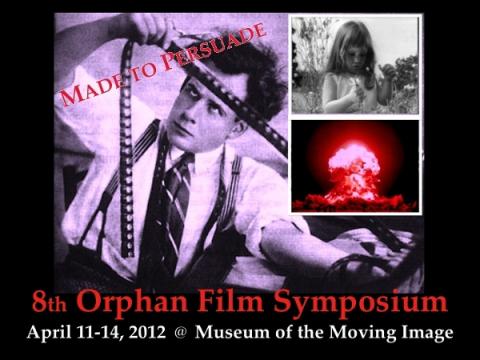Film Enthusiasts Address the Importance of Rescuing ‘Orphan Films'

The 8th Orphan Film Symposium: “Made to Persuade”
What is an “orphan film?” This month (from April 11-14), more than 300 film enthusiasts, filmmakers, programmers, scholars, and archivists congregated in the newly renovated Museum of the Moving Image in Astoria, Queens, to address this question.
Loosely defined, an orphan film is one that has been abandoned by its original owner or producer, a decaying print with no prospect for distribution. The stories behind some of the films in this year’s 8th biannual Orphan Film Symposium program were nothing short of heroic. From the tedious labor of sorting through university archives, to the Herculean efforts of procuring state funding to restore disintegrating film reels, to the lives and limbs risked in order to shoot these films in the first place, Orphans provides a unique and crucial venue for exhibiting and historicizing the filmed fragments that have dropped out of cultural visibility and circulation.
The topic, “Made to Persuade,” showcased a gamut of ideological agendas: historical U.S. presidential campaign films, Maoist propaganda, New Deal advocacy works, 1960s Sugar Crisps cereal commercials, sex-education classroom videos, and even Soviet protocols in “intellectual Lamaze”—“pain is unnatural, whereas giving birth is very natural.” If you discover a film with a persuasive but at first glance obsolete rhetoric, chances are it would have been a good candidate for inclusion in the 2012 Orphans 8 program.
Since these films were all originally “made to persuade” people to do, think, or feel things within very specific historical and geographical contexts, our inherent attraction to them can now feel somewhat mystifying, if not ideologically illegible. For example, what can we learn from watching a children’s disability advocacy film from 1951 (Children Limited), which ostensibly argues that intellectually handicapped children are in fact capable of learning and experiencing emotions? What does it mean to be persuaded by the rhetoric of a historical throwback? Orphans attempts to fill in these contextual ambiguities with introductions and follow-up Q&As by experts in the field. Children Limited’s historical role in legal and legislative discourses of disability advocacy was incisively framed by a panel of scholars and practitioners, including a disability justice lawyer (Larry Jones), anthropologist (Faye Ginsburg), and media historian (Laura Kissel).
On a meta-level, perhaps it is instructive to witness outmoded discourses on childhood orphanage—everything from “test-tube babies, bastards, and fugitives” (the title of the opening morning panel) to intellectually handicapped children whose parents abandon them to state institutions—for forging new contexts for orphan film spectatorship in 2012.
Distribution and exhibition require cultural as well as financial capital. When a film persists, slowly decaying in a government archive with no one to bring it to a light, perhaps something decisive about our culture needs to shift in order for us to recognize the relevance of these unmoored historical leftovers, or to “persuade” us to do the research and archival advocacy necessary to forge their relevance anew. This is precisely the project that Dan Streible helms biannually (with the dedicated support of his M.A. students at the NYU Moving Image and Archiving Preservation Program).
The 2012 symposium kicked off with a silent German film, The Elevated Train Catastrophe (Valy Arnheim, 1921), introduced by University of Chicago Film Professor Tom Gunning, and replete with live musical accompaniment and a live lecturer. The film depicts “the 16th sensational adventure of Master Detective Harry Hill” who races against the clock to try to thwart locomotive terrorist attacks by a menacing underground group known as “The Invisible Power.” From a narrative feature film about German interwar train espionage, to the last film on closing night, Light Cavalry Girl (Jie Shen, Beijing, 1980), a Chinese documentary about female motorcyclists during the Cultural Revolution, the symposium spanned just about every fathomable mode or discourse of orphanhood.
Other highlights included One Friday (Rolf Forsberg, 1973), a surprisingly optimistic film depicting the aftermath of an all-out race war in L.A.; short films by this year’s “Helen Hill Awardees” Jo Deri and Jeanne Liotta; Francesca Feeding the Chickens (1905), a very short clip of a woman named Francesca feeding her chickens with her family members present to offer their own biographical memories for historical framing; Hans Richter’s Stock Exhange, an epic, satirical history about the development and acceleration of capitalist practices of exchange; and many more.
Filmmaker Lillian Schwartz was present (in a wheelchair and having just started to recover partial vision) to answer questions about a series of abstract 3-D films that she made in the ‘70s: UFOs, Pixillation, Olympiad, Papillons, and Galaxies. Schwartz’s films anchored a panel on telecommunications, which also featured a structuralist film by Bill Brand (Touch Tone Film, 1973), and a hilarious documentary about all of the bizarre requests and propositions encountered by AT&T telephone operators in the 1960s (Operator, Nell Cox, 1969).
While Operator attempts to document all of the quirky and potentially obscene moments that vanish due to the impermanence of telecommunications, The Worlds of Dr. Vishniac (featured in the “Popular Science” panel) sets its sights on the realm of the microscopic, which it then proceeds to make visible to the naked eye. Scientist Roman Vishniac deeply espoused the use of cinema to explode the everyday barriers between invisibility and the microscopic. These orphan films are just as much about the capacity of the cinematic medium to document overlooked and impermanent forms of the world around us. It would be a shame to lose these images forever due to the complacency of our present economy for media distribution.
If ever there was a case and point for the political relevance of the archive, Yale University Film Professor Charles Musser hit it home with a series of presidential campaign films that he introduced from the ’48 election: Harry Truman, Tom Dewey, and Henry Wallace. Strom Thurmond, the States’ Rights Democratic Party nominee, unfortunately did not produce any propaganda films because his campaign did not believe in 20th century media. Despite our obsession and oversaturation today with political campaign discourse, the differences between a Dewey ad from ’48 and an Obama ad from 2008 were palpable and very instructive to witness.
Later that afternoon The Best-Fed Baby (1925) won the crowd over -- a health education film about a negligent mother whose doctor teaches her how to produce greater quantities of breast milk to nurse her (already suspiciously rotund) baby. The moment of persuasion arrived when the negligent suburban mother visits the farm where she had grown up to watch her family’s cows being milked at the teats—and never again would her baby go “hungry.”
From the quirky annals of maternal self-improvement, the symposium quickly switched gears to inner-city images of motherless children, featuring a selection of community youth filmmaking projects from New York City, Los Angeles, and Philadelphia. The Jungle (1967), a favorite of the symposium presented by Jay Schwartz and Louis Massiah, provides a rare inside glimpse of the dealings of an Oxford Street gang in North Philly. The gang members formed their own short-lived production company, “12th and Oxford St. Film Corporation,” and recently had their film registered at the Library of Congress.

The orphan film indeed defies genre, nation, or time period, which is perhaps a reason why these films seem so hard for us to classify; they are uncanny fragments from our history, both placeless and eerily recognizable. At the very least they are quirky. Chucky Lou: Story of a Woodchuck (Indiana University Audio-Visual Center, 1948) is primarily relatable on the register of its bizarreness. Chucky Lou documents the plight of a woodchuck “rescued” from the wild and boarded in a cage at a state park. The film opens with a woman who “didn’t know how to care for a woodchuck, so she took it to her husband,” and then follows Chucky Lou while she slowly eats her way to woodchuck obesity on her favorite food (peanut brittle), which she earns in exchange for tolerating the local school children dressing her in dolls’ clothes.
The symposium’s geopolitical range matched its thematic broadness: from Czech Army Films (with filmmaker Vojtech Jasny present to discuss his war experiences in the Czechosovak Army), to a Ghanaian production of Shakespeare (Hamile: The Tongo Hamlet, 1964); and from the Dutch East Indies in the 1920s, to 1960s Soviet fantasies of childhood space travel (The Flight to Thousands of Suns, Aleksei Yerin, 1963). We relived community youth filmmaking from East Coast to West Coast, and witnessed documentary fragments from the heartland to the cosmopolis. We revisited News of Iran from 1954, and memorialized TV News cameraman Bill Birch—best known for his coverage of “The Poison Grain” story about a family afflicted with Mercury poisoning in New Mexico.
Orphans thematized the precariousness of its own media vehicles by opening with a fiction film about a German train catastrophe, and then asserted an unshaking rhythm with the symposium’s closing images of female stunt motorcyclists in Cultural Revolution Beijing. From catastrophe to synchronicity, Orphans-goers literally traversed every imaginable space in-between.
If attendees were “persuaded” of anything—be it Henry Dewey’s political viability circa 1948 or the deliciousness of 1960s sugary breakfast cereals iconized by “Dino the Sugar Bear”—it is that orphan films deserve a “home” more than once every two years.
*The 2014 Orphans Film Symposium will take place at the EYE, the recently renovated and reopened moving image museum in the Netherlands.
Author Bio:
Maggie Hennefeld, a contributing writer at Highbrow Magazine, hails from Brooklyn, N.Y., and currently lives in Providence, R.I., studying in a Modern Culture and Media Ph.D. Program at Brown University. She worked for four years during college as a writer and section editor of 34th Street, the weekly Arts and Entertainment magazine of The Daily Pennsylvanian. Maggie has published in academic journals including Screen and Media Fields and has articles forthcoming in Alphaville and Comedy Studies. She is currently working on her dissertation, titled “The Politics of Film Comedy: From Vaudeville to Terrorism.”
Photos: NYU - 8th Orphan Film Symposium




























































































































































































































































































































